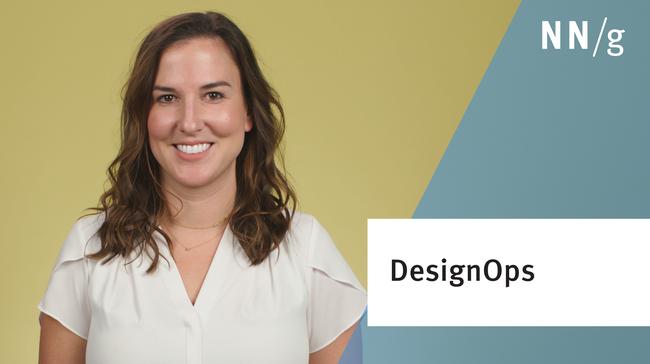Design Operations (DesignOps) refers to the orchestration and optimization of people, processes, and craft in order to amplify design’s value and impact at scale.
In order to understand how DesignOps efforts are understood, prioritized, and implemented across organizations, we asked 557 UX and design professionals in a variety of industries about the following:
- The presence or absence of DesignOps-related activities and artifacts across design teams
- The presence or absence of DesignOps roles
- The extent to which DesignOps is valued or understood at their organization
The DesignOps Framework
Our DesignOps framework has 3 core areas:
- How we work together: How teams organize and align around shared responsibilities, establish effective measures for collaboration, and enable employee development
- How we get our work done: How teams use processes to achieve consistent design quality, establish repositories for knowledge sharing and efficiencies, and effectively prioritize projects
- How our work creates impact: How teams measure design work, share and reward team success, and enable others — even those outside of the team — to learn and use design and research activities

DesignOps Related Activities and Artifacts
In order to understand the extent of DesignOps efforts within organizations, we used the DesignOps framework to organize a set of related activities and artifacts that are indicative of DesignOps maturity. We then asked survey respondents to identify which of those activities and artifacts were present at their organizations. A list of 34 total items across the 3 core areas was presented, as shown in the table below. All items within the list help amplify design’s value and impact, and are, therefore, related to DesignOps.
How We Work Together |
How We Get Work Done |
How Our Work Creates Impact |
|
|
|
| How We Work Together |
|
| How We Get Work Done |
|
| How Our Work Creates Impact |
|
Extent of DesignOps Activities
On average, practitioners reported the presence of just 7.5 of the 34 total items at their organization (or 22%). The breakdown of average number of items reported for each core area was as follows:
- How we work together: 18% (2.2 items of 12)
- How we get our work done: 20% (2.2 items of 11)
- How our work creates impact: 30% (3.2 items of 11)

The number of items reported is certainly disappointing, if not surprising. (We know from our studies on UX maturity that there are still many organizations with low overall UX maturity despite the growth of the UX profession.) Further disheartening is that the mode for the number of items reported for each core area was 0. That is to say, for each core area, the majority of people reported the absence of every single listed activity and artifact!
The following sections dive deeper into the percentage of specific activities reported within each of the 3 core areas.
How We Work Together
Activities related to this area of DesignOps are indicative of how well teams:
- Organize: Structure and build teams
- Collaborate: Communicate effectively
- Humanize: Enable employee development and growth

Organize
Only 32% of respondents reported having a shared, documented organizational structure (or “org chart”). Not having a transparent org chart could contribute to the fact that less than a third of people report having well-balanced teams with complementary skillsets. Less than half (39%, confidence interval from 34% - 44%) of design-team leaders have a role on the same level in the org chart as leaders from other departments (a good indicator that design is equally represented and valued in strategic conversations at those organizations).
Collaborate
Of the three subareas for How We Work Together, efforts in collaboration are least terrible. 40% of respondents reported that they have regularly occurring meetings to share work and collaborate, and about a third reported that they have a physical work environment conducive to collaboration (34%) and formalized ways to share ideas with others who have common interests (35%). We cannot say, however, whether the presence of these items actually benefits the team. (Though a good sign, the fact that meetings regularly occur doesn’t necessarily mean they are productive, for example.)
Humanize
Humanize is where teams suffer the most within the first area of the framework. Only 11% of teams have a documented, shared career ladder or growth path for designers. Furthermore, advancement pathways are limited: 82% of practitioners said that there is no way to advance outside of managerial roles. Hiring and onboarding is also dire: 79% of teams do not have a process for consistently, objectively interviewing design-team candidates and 84% do not have clear milestones or progress checkins to help new team members understand if they are meeting expectations once hired.
How We Get Our Work Done
Activities related to this area of DesignOps are indicative of how well teams:
- Standardize: Use consistent tools and processes
- Harmonize: Share resources and insights
- Prioritize: Decide what to focus on and why

Standardize
As far as standardization, very few (17%) of teams document and share a standard design process. Tool usage fairs slightly better: 39% of teams use a consistent, complementary toolset, and 38% work in the same software with external partners.
Harmonize
Even though 25% of practitioners reported having a research repository (a collection of searchable research insights collected over time that aims to make research collaborative and accessible), only 13% reported being able to easily search these repositories. Slightly larger numbers of practitioners have a shared pattern library or front-end style guide (38%) or a shared repository for design artifacts and templates (40%).
Prioritize
Less than a third of practitioners reported operating within a comfortable capacity (i.e., not too little or too much workload) and on projects that are reasonably estimated in terms of budget and timeline.
How Our Work Creates Impact
Activities related to this final area of DesignOps are indicative of how well teams:
- Measure: Define and track design quality
- Socialize: Educate others about design’s role and value
- Enable: Cultivate organization-wide use of design activities

Measure
The lack of UX-measurement efforts is alarming: Very few respondents said they use a consistent set of design metrics (13%) or track those metrics over projects even if they do have them (9%). Furthermore, only 6% reported having a consistent process for objectively measuring quality across projects.
Socialize
It appears that the majority of practitioners do not have either the bandwidth, authority, or soft skills necessary to promote their team’s value. The fact that only 14% reported that they have a consistent way of describing the role and value of design to people outside their team (and that just under a quarter share case studies or success stories), makes it unsurprising that 80% of respondents said that design’s role and value is not understood across their company.
Enable
Sharing design and UX processes and encouraging the use of those processes by nondesigners helps scale the impact of design within an organization; yet, less than a fifth of practitioners said such activities are documented and shared or that there is related training available for nondesigners. On a slightly more positive note, 44% and 46% report that nondesigners are involved in design activities and research activities, respectively. This type of exposure increases awareness and understanding of the value that UX and design practitioners add within an organization.
Presence of DesignOps Roles
Another clue for understanding the state of DesignOps maturity across organizations is the presence of DesignOps roles.
Only 20% of respondents worked at a company with one or more people dedicated to DesignOps. The majority of respondents reported that there was no one at their organization managing DesignOps activities and that teams used resources, tools and processes in an ad hoc and inconsistent fashion.

We could make an assumption that the lack of DesignOps-dedicated roles is surely related to the lack of DesignOps efforts and activities across organizations. Assessing and documenting team skills and structure, standardizing processes and tools, and socializing the design team’s value are all activities that take effort and time, and the lack of dedicated DesignOps roles suggests that these activities often fall to people with other core job responsibilities (like designing and researching).
The number of people who reported specific DesignOps roles, such as producers, program managers, ResearchOps specialists, or DesignOps leads or managers, is very low. This could suggest that even companies who understand the value of and need for DesignOps start small, with relatively few dedicated roles.

Self-Reported DesignOps Maturity
Finally, we inquired about how well the role of DesignOps is understood and valued at their organization by asking practitioners to rate their organizations on a spectrum of predetermined levels:
- Level 1: The role and value of DesignOps is rejected or dismissed. The company denies the need for standardized processes, methods or tools to support design work.
- Level 2: The role and value of DesignOps is not well understood. Some people may be executing a few DesignOps activities, but these activities often happen by accident, not from strategic intent. They are ad hoc and undocumented.
- Level 3: Some key players or individual teams understand the role and value of DesignOps. DesignOps activities are usually present in small groups or departments, not the entire company. There is little coordination across teams.
- Level 4: There is broad understanding of the role and value of DesignOps. DesignOps activities are executed with strategic intent, and best practices are shared across teams or departments.
- Level 5: The role and value of DesignOps is established and ingrained within the company culture. DesignOps activities are coordinated, automated and streamlined across all teams.
Only 10% of respondents reported a level 4 or 5 of DesignOps maturity. The majority of the respondents belonged to organizations at levels 2 and 3.

These fairly low scores may indicate a fair understanding and self-awareness of the low DesignOps effort at organizations as suggested by the lack of DesignOps activities and roles reported above.
Conclusion
The survey data indicates that the majority of organizations have low DesignOps maturity: Most organizations appear to simply not be doing very much when it comes to elevating the impact and value of design at their organization, with neither activities nor roles dedicated to that aim. The low self-reported DesignOps maturity levels across respondents indicates that practitioners are acutely aware of that gap.
Clearly, there’s work to do. It’s hard to argue with the fact that transparent org charts, career pathways, balanced teams, and consistent toolsets (to name a few blatantly underrepresented items in the survey) benefit UX and design practitioners, yet the overwhelming majority of organizations seem not to prioritize these items. There is an obvious void and clear opportunity for DesignOps activities and roles. DesignOps is needed, and newly introduced DesignOps-dedicated roles could undoubtedly hit the ground running at many organizations.
Hopefully this data can provide a baseline and benchmark for growth as DesignOps value grows and efforts are increased to fill these voids. The low percentages reported here present an opportunity for organizations that want to adapt DesignOps, because it won’t take much to reach parity with the current average state. And it won’t take that much more effort to leapfrog the competition and become best in class.




